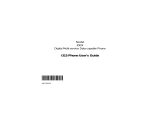3. Insert the SIM card.
1. Rotate and extend
the antenna.
2. Remove battery door.
4. Push down and slide the
SIM card tray to the right.
6. Install the battery by
matching arrows on phone
and battery.
5. Remove battery’s
protective cover.
7. Attach battery door
cover or optional
Cellular Cassette.
8. Attach charging device.
Getting Started
Turn the phone's power on/off:
Press and hold
S.
Place a call:
Rotate and extend the antenna in a vertical position. To dial,
press: [
0 0
]
or
[
0
and hold for two seconds], [country code],
[phone number],
O
.
End a call:
Press
C.
Adjust earpiece volume:
Press upper and lower volume keys on the side of the phone.
Adjust ringer volume:
Press
E and then the upper and lower volume keys on the side of
the phone.
Answer a call (with antenna rotated and extended):
Phone rings and/or vibrates
After Call
followed by Answer? is in display, press O.
Answer a call (with antenna stowed):
Phone chirps
Rotate and extend antenna
Phone will ring and/or vibrate
After Call
followed by Answer? is in display, press O.
Clear the last digit in the display or exit a submenu:
Press
C.
Clear the entire display or exit the menu system:
Press and hold C.
Select prompt language:
Press and hold
C to return to idle display.
Press M 2 6 O to go to the language selection submenu.
Press M until you see the preferred language.
Press O to select.
Display your phone number:
Press Q #.
Also refer to the “View Your SIM Card Phone Number(s)” section of the
User’s Guide.
Basic Operation
Special Features
Special Features Continued
9505 PORTABLE QUICK REFERENCE
Find Name
1
E
Mute
Call Voicemail
Lock Now
Battery Meter
Recall a number from the phone book:
1. Press Q.
2. Enter the one-, two-, or three-digit location number of the entry,
and then press O.
3. Press O to call the displayed entry.
Recall last ten numbers dialed:
1. Press M until you see Phone Book, and then press O.
2. Press M to scroll to Last Ten Calls, and then press O to select.
3. Press M to scroll to Last Calls Made and then press O to select.
4. Press M to scroll to the number you are looking for.
5. Press O to place a call to that number.
Quick Access Menu
Phone Book
2
3
4
5
Vibrate On/Off
Read Messages
Register Now
Forward On/Off
6
7
8
9
Switch modes:
1. Press M until you see Mode Selection, and then press O.
2. Press M to scroll to Cellular Preferred, Satellite
Preferred
, Cellular Always or Satellite Always.
3. Press O to select.
Keypad disable:
Press * and # keys simultaneously to prevent accidental usage
of the phone. All keys with the exception of the S key will be disabled. You
can still answer an incoming call by pressing
O when the keypad is locked.
To remove the keypad disable, press * and # simultaneously.
Factory default for satellite and cellular mode.
(Top)
(Top)
(Top)
✁




















